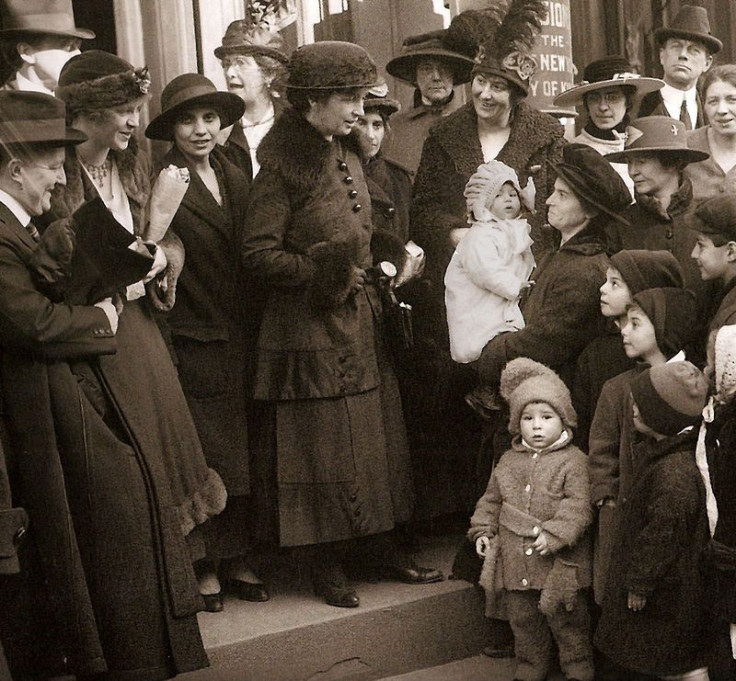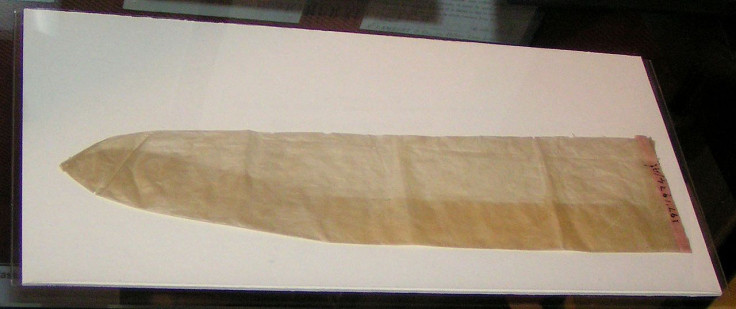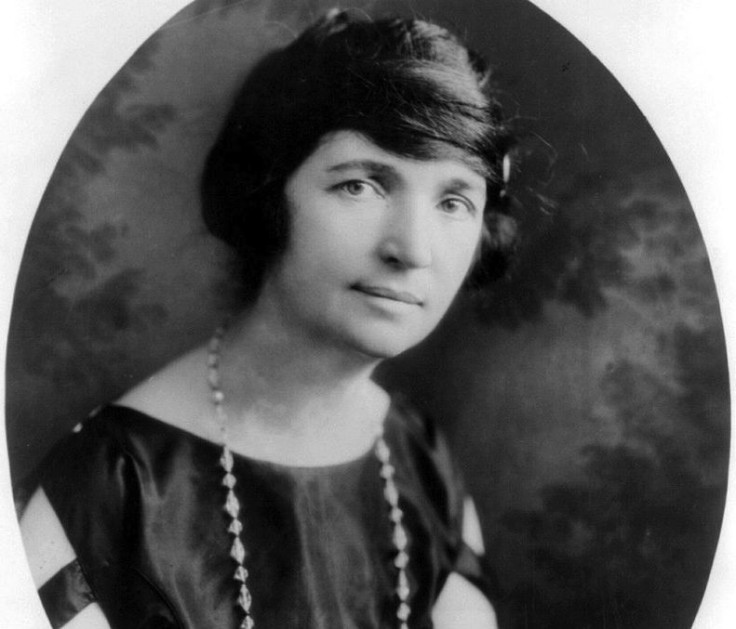The History Of Birth Control: How We’ve Been Trying To Prevent Babies Since The Beginning Of Time

Birth control: two words that hold plenty of controversy, heated emotions, and in many cases, consequences that can change one’s life. In the modern world, contraception has somehow garnered a bad reputation, considered by some an unnatural way to toy with pregnancy and bearing children — particularly among certain religious groups.
The reality is, birth control is as old as medicine itself. Humans have been trying to prevent pregnancy since having babies was possible (essentially, since human life itself existed) — either through abstinence or bizarre concoctions that would make any modern day lover squirm. In addition, throughout many different cultures and time periods across the world, abortion was considered a solid means of birth control, as it didn’t hold the negative stigma that it does today.
ANCIENT TIMES

Prehistoric. Some archaeologists believe that the very first depiction of condoms — and birth control entirely — exists on the walls of a cave in France known as the Grotte des Combarelles, where cave drawings dating back to 15,000 years ago show men with a covering of sorts over their genitalia. However, it’s still debated whether these drawings are referring to contraception.
The Bible. Perhaps the age-old form of birth control is what the Bible refers to as coitus interruptus, more commonly known as “pulling out.” It’s the easiest and simplest way to avoid insemination — but it’s also known to be risky and often ineffective. The book of Genesis actually instructed men to practice coitus interrupts and to “spill their seed” on the ground instead of inside a woman to prevent children.

1850 BC - 100 BC. Meanwhile, ancient dwellers in Mesopotamia, Egypt, and Rome documented their experiences using both abortion and birth control. The Ebers Papyrus, an Egyptian medical document from around 1550 BC, is one of the earliest descriptions of birth control. Back then, Egyptian women created a mix of honey, acacia leaves, and lint, then placed it into their vaginas as a way to block sperm. Another mixture included acacia gum — which is now known to contain spermatocidal qualities and is actually used in some current contraceptives. Perhaps the strangest concoction used in ancient Egypt included crocodile dung, honey, and sodium carbonate placed inside the vagina.
Many of these ancient examples of birth control today seem outlandish, and have been deemed ineffective by science — and were oftentimes outright dangerous. In ancient China, women who no longer wanted to have children received a “prescription” for a sterilizing mix of oil and quicksilver, which were heated together and then drunk. Other accounts claim that concubines in China drank lead and mercury together to prevent pregnancy, but this was so dangerous that the side effects included brain damage, kidney failure, and even death.
Condom-like creations , such as the bladders or skins of animals, were used inside women as well in ancient Rome and Egypt.
THE MIDDLE AGES

1484. Contraception and abortion may have been widely accepted and used in ancient civilizations, but enter the Catholic Church in the medieval era and options for women came to a staggering halt, at least in theory. In 1484, Pope Innocent VIII officially approved the Inquisition and the “witch” hunt that followed. Included in those laws was the demand to find witches who had “slain infants yet in the mother’s womb” and “hindered men from performing the sexual act and women from conceiving,” referring to abortion and contraception, respectively.
It has indeed lately come to Our ears, not without afflicting Us with bitter sorrow, that in some parts of Northern Germany… many persons of both sexes, unmindful of their own salvation and straying from the Catholic Faith, have abandoned themselves to devils…have slain infants yet in the mother’s womb, as also the offspring of cattle, have blasted the produce of the earth, the grapes of the vine, the fruits of the trees… (The Bull of Innocent VIII )
1494. While the cave paintings in the Grotte des Combarrelles may have hinted at prehistoric condom use, we aren't entirely sure that’s what they mean. And while condom-like animal skins were discovered in ancient Egyptian tombs, the first real documentation of condoms didn’t occur until 1494, when an outbreak of syphilis tore across Europe and Asia. Because Christianity and Islam at the time forbade birth control, instead preaching abstinence, sexually-transmitted diseases spread quickly during the medieval era.

1564. The medical book of Gabriele Falloppio, an Italian physician, was published, and it was the first to describe the use of what many believe is the initial invention of the condom, at least in Europe. In De Morbo Gallico, Falloppio describes his creation — linen sheaths soaked in chemicals and dried before being placed on the penis and tied with a ribbon. Falloppio’s “device” was developed as a response to the syphilis epidemic, which had continued to rage throughout Europe for the past century. He claimed that when men wore the device, they were protected from syphilis. Since the medieval Catholic Church labeled people who advocated contraception as “witches,” these early condoms were used primarily to prevent STDs rather than pregnancy — and many people secretly continued to use homemade remedies of birth control.

The Renaissance. In the early medieval period, particularly pre-15th century, certain “glans condoms” were found in Asia. These typically only covered the tip of the penis, and were used as birth control. In China, glans condoms were made of oiled silk paper or lamb intestines (similar to sausage casings — which also contributed to condom creations). Well into the Renaissance period, people in Europe began using animal intestines and bladder as condoms as well.
THE MODERN ERA
1827. Scientists discovered the female egg, the ovum, in 1827 — making a breakthrough in reproductive knowledge. This was the first step in helping scientists better understand how human reproduction occurs, and how to ultimately prevent it.
1839. Charles Goodyear vulcanized rubber for the first time and began manufacturing rubber condoms, intrauterine devices, and diaphragms. In the next 30-40 years, dry-goods stores and pharmacies began offering birth control options across America, including condoms, diaphragms, and cervical caps.

1914. Enter Margaret Sanger, a nurse working in New York City’s Lower East Side, who became one of the most staunch supporters of birth control in America. Sanger herself coined the phrase “birth control” during this time, and published a journal called The Woman Rebel, in which she instructed women on the advantages of avoiding pregnancy if they were exceptionally ill or poor. She also penned her ideas about a “magic pill” that could prevent pregnancy just as easily as an aspirin.
However, the anti-obscenity Comstock Law, passed in 1873, listed contraceptives as “obscene” and barred them from being distributed through the postal service. Still, this didn’t stop a group of NYC women from establishing the National Birth Control League, which would later lead to Planned Parenthood.
1916. Sanger opened the first birth control clinic in the U.S., located in Brooklyn, New York, where women could receive information and instruction about birth control. However, 10 days after it opened, the “vice squad” raided it and shut it down, confiscating all the condoms. A few years later, in 1918 — after Sanger went to court for running the clinic — the Crane decision became the first to allow birth control for therapeutic purposes.

1920s. Condoms until now were made of rubber — but the invention of latex, rubber in water, ushered in a quicker and easier way to manufacture condoms. Youngs Rubber Company began producing latex condoms in the 20s.
1937. Finally, after years of secretive contraceptives being sold under the ruse of “feminine products,” the American Medical Association officially declared birth control to be a legitimate medical practice. One year later, the federal ban on birth control was lifted, and birth control clinics exploded across the country.
1960. On May 9, 1960, the FDA approved the very first oral contraceptive pill. Known as Enovid, or simply “The Pill,” the oral contraceptive revolutionized birth control. Within five years, over 6 million American women were taking the pill. In addition, until now, states had their own birth control laws — and many banned contraceptives. But in 1960, the Supreme Court removed state bans — but only for married couples.
1972. Birth control was declared legal for everyone in 1972, including unmarried women.
1981. In the early 80s, AIDs became a widespread disease that was soon discovered to be sexually-transmitted. As a result, politicians pushed both condoms and abstinence as a way to prevent AIDs from spreading, and everyday supermarkets like Wal-Mart began providing condoms.
Today. By now, millions of women in America and all over the world are using the pill; but criticism of contraception still exists, and perhaps even more so now than before. The Catholic Church still takes an adamant stand against abortion and all contraceptive use. In addition, because Sanger had been associated with eugenics, and had believed in eliminating poor minorities and immigrants through birth control, many still view contraception and Planned Parenthood with suspicion — claiming that Sanger had wanted to wipe out the African-American population. These concerns are still relevant today in discussions about birth control, abortion, race, and politics.
While Sanger’s moral and racial beliefs are certainly questionable, at this point we can rest assured that Planned Parenthood and birth control are not being used to sterilize certain racial or minority groups. Instead, birth control is a choice every woman can make on her own — and Obamacare providing access to free oral contraceptives marks a breakthrough in how the federal government views choice. Opponents to abortion and birth control still remain, but at least now women have safe, effective, accessible options.



























